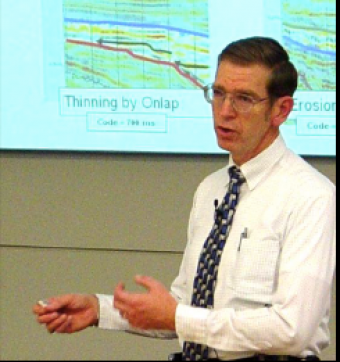This lesson gives a brief overview of seismic data acquisition. Acquisition surveys are expensive and critical - a lot of science goes into survey design and acquisition. A seismic image combines both seismic data acquisition and seismic data processing. Each works together to produce the best final image. The acquisition process includes generating a signal with an energy source, and detecting and recording the reflections using receivers. The ultimate goal is to create a 2D line or 3D volume of seismic data that adequately samples the geology being mapped. We want to optimize the data through signal enhancement and noise reduction.
The class time should be divided into three (3) segments. The first segment should be a review of the previous exercise (Exercise 15), followed by the lecture and an introduction to the exercise (Exercise 16). The review of Exercise 15 has 13 slides, and should take ~15 minutes to explain. Lecture 16 contains ~45 slides, and takes about 60 minutes to explain. The introduction to Exercise 16 has five (5) slides, and should take ~10 minutes to explain. Thus, plan to spend ~85 minutes on the material. If your class is more of a geologic emphasis, you might skip Lessons 16 and 17.
This exercise highlights how to build a fold chart for the start of a marine seismic line. It helps students understand the concepts of midpoints and fold. The exercise instructions show how to handle shot 1 and shot 2. The exercise should take no more than ~15 minutes for students to complete.
At the end of this lesson, students should be able to:

This course, based on teaching material from Dr. Fred Schroeder (formerly of Exxon/ExxonMobil), reflects on the geology and geophysics basics for the petroleum industry. General geology and basic geophysics are not required, but helpful with the material.
We encourage the reuse and dissemination of the material on this site as long as attribution is retained. To this end the material on this site, unless otherwise noted, is offered under Creative Commons Attribution (CC BY 4.0) license